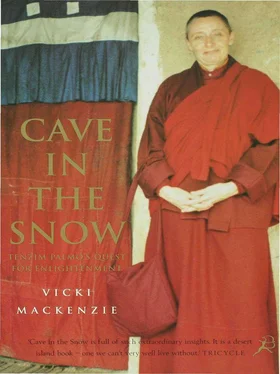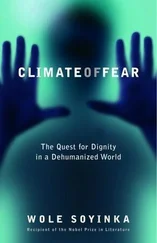Before that breakthrough occurred, things in Dalhousie went from bad to worse. Of all the discrimination that Tenzin Palmo suffered, the hardest to bear was being refused the esoteric teachings and the sacred rituals – the very essence of Tibetan Buddhism, containing the methods that lead directly to Enlightenment. It was what she had become a nun to find. The path to perfection had come within her grasp and then been denied her. The reason, yet again, was solely because of her gender. Women, they said, had never been given access to these sacred truths. And so as the ceremonies and the ritual dances went on inside the temple, she sat literally outside looking in. And when she asked to be taught the secret texts she was refused. Instead she was delegated to Choegyal Rinpoche, one of her guru’s closest disciples, who proceeded to tell her nice, simple Buddhist stories. It was the way they thought a woman, a Western woman, should begin.
Her frustration was enormous. ‘It was like being at this huge banquet and being given a few little crumbs here and there. It drove me nuts. I could get absolutely nothing in depth,’ she said. ‘If I had been a man it would all have been so different. I could have joined in everything. Really, it was such a male-dominated situation. It was as though I had entered a big male club. The monks were very kind to me, but on a deeper level there was resentment. They regarded having a woman on their turf as a challenge!’
Tenzin Palmo had hit the spiritual glass ceiling – the one which all Buddhist nuns with spiritual aspirations crashed into. Over the centuries they had had a raw deal. While their male counterparts sported in the monastic universities, engrossed in profound scholarship and brilliant dialectical debate, the Tibetan nuns were relegated to small nunneries where, unable to read or write, they were reduced to doing simple rituals, saying prayers for the local community or, worse still, working in monastery kitchens serving the monks. This was why there were no female Dalai Lamas, no female lineage masters. Shut out from the Establishment, denied learning and status, they were not even starters in the spiritual selection stakes.
Their sisters in the southern schools of Buddhism had it worse. In Thailand the nuns had to shuffle backwards on their knees away from any monk and never allow any part of their body to touch his meditation mat. Those with big breasts were ordered to bind them up so as not to appear overtly female!
The root of the problem had gone back to the time of the Buddha (and even before that), when women were regarded as chattle with no rights of their own. In such a climate the Buddha is reputed to have refused women into his newly formed order. Probably, it is argued, because he felt the mendicant life would be too difficult and too dangerous for the ‘weaker’ sex. There were more insidious objections, too. Women, it was held, were lesser beings who were simply not capable of attaining enlightenment. Their bodies forbade it. They were defiled. Shariputra, one of the Buddha’s main disciples, summed up the feelings of his day when he, on hearing of an eight-year-old girl who had reached Awakening, had exclaimed: ’This thing is hard to believe. Wherefore, because the body of a woman is filthy and not a vessel of the Law.’
This set the tone for the prejudice and discrimination which followed. In Tibet, where the word for woman is ‘inferior born’, it was written that ‘on the basis of her body’ a woman was lesser than a man. Consequently at any religious ceremony the nuns had to sit behind the monks, and in the offering of the butter tea the most senior nun would be served after a monk of one day’s ordination. To compound it all, they were given a lesser ordination than the monks, thereby confirming them in the eyes of society as second-class spiritual citizens.
The effect of all this on the women, as Tenzin Palmo was now discovering for herself, was crushing. Their self-confidence in their ability to get anywhere on the spiritual path was reduced to virtually zero. ‘Among Tibetan women their main prayer is to be reborn in a male body. They are looked down upon from all sides. It is so unfair,’ Tenzin Palmo commented. ‘I once visited to a nunnery where the nuns had just come back from hearing a high lama teach. He had told them women were impure and had an inferior body. They were so depressed. Their self-image was so low. How can you build a genuine spiritual practice when you’re being told from all sides that you’re worthless?
‘At one point I asked a very high lama if he thought women could realize Buddhahood, and he replied that they could go all the way to the last second and then would have to change into a male body. And I said, “What is it about a penis that is so essential for becoming Enlightened?” What is it about the male body that is so incredible?’ she asked, forthright as ever.
‘And then I asked if there was any advantage in having a female form. He said he would go away and think about it. The next day he came back and said, “I have been thinking about it and the answer is ‘no’, there are no advantages whatsoever.” I thought, one advantage is that we don’t have a male ego.’
Urged on by her own unhappiness and the blatant unfairness of it all, Tenzin Palmo began to research the reasons for this loathing of the female body. Her findings were illuminating. ‘The Buddha never denied that women could become Enlightened,’she said. ‘In the early sutras the Buddha talked about thirty-two points of the body which were to be meditated on in depth. The meditator had to visualize peeling the skin off to examine what really was there – the guts, the blood, the pus, the waste matter. The Buddha’s purpose was twofold: to create detachment from our obsession with our own body and to lessen our attraction to other people’s bodies. The idea is that one is much less fascinated when one sees a skeleton stuffed with guts, blood and faeces! However, the writings later change. When you get to Nagajuna who wrote in the first century AD, and Shantideva, the object of contemplation has turned specifically to a woman’s body! The meditator now has to see the woman’s body as impure.
’The Buddha was truly Enlightened and saw things as they really were. Others, however, used the Buddha’s insights to serve their own purposes. So, rather than looking at our identification and obsession with the physical, the Buddha’s teachings were used as a means of arousing disgust towards women. If you have a monastic set-up, it is useful to view woman as “the enemy",’ she added pointedly.
The idea that women were ’dangerous’, wiling men away from sanctity and salvation by their seductiveness and rampant sexuality, was as old as the fable of Eve herself. Tenzin Palmo was having none of it: ’Really! It’s not the woman who’s creating the problem, it’s the man’s mental defilements. If the man didn’t have desire and passion, nothing the woman could do would cause him any problem at all,’ she said. ‘Once a lama accused me of being seductive and causing him difficulty. I was aghast. “I’m not doing anything to you, it’s your own mind,” I protested. He laughed and admitted it was true.
‘It’s the man’s problem and he blames it all on her!’ she continued. ‘Women are supposed to be these lustful, seductive creatures but when you look at it, it’s absurd. Who has the harems? Do women have courts of men on hand to satisfy their sexual needs? Are men afraid to walk in the streets at night in case women will jump on them and rape them? Look at men in prison and the army, how they behave together! And how many male prostitutes are there? Even the male prostitutes that do exist are there to satisfy other men,’ she said, warming to her theme. ‘It’s all unbelievable projection. Men have this big problem and they put it all on to women because females happen to have a shape which is sexually arousing to them. Women don’t even have to wear seductive clothing for men to be turned on. When I was young and going through the phase of pulling my hair back and wearing big sweaters and no make-up I had just as many boyfriends and admirers as when I dressed up.’
Читать дальше












